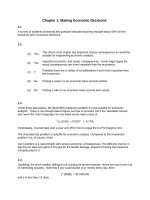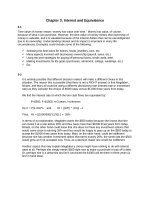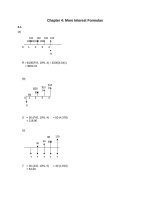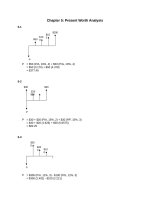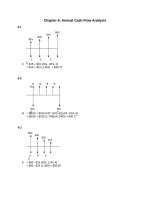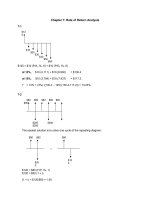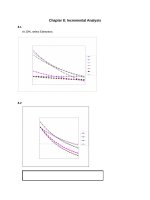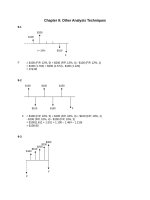Solution manual engineering economic analysis 9th edition ch05 present worth analysis
Bạn đang xem bản rút gọn của tài liệu. Xem và tải ngay bản đầy đủ của tài liệu tại đây (117.02 KB, 33 trang )
Chapter 5: Present Worth Analysis
5-1
$10
$50 0
$15
0
$200
P
P = $50 (P/A, 10%, 4) + $50 (P/G, 10%, 4)
= $50 (3.170) + $50 (4.378)
= $377.40
5-2
$30
$30
$20
$20
P
P = $30 + $20 (P/A, 15%, 2) + $30 (P/F, 15%, 3)
= $30 + $20 (1.626) + $30 (0.6575)
= $82.25
5-3
$30
0
$20
0
$10
0
P
P = $300 (P/A, 12%, 3) - $100 (P/G, 12%, 3)
= $300 (2.402) - $100 (2.221)
= $498.50
5-4
$50
$50
$50
$50
$50
$50
Q
Q = $50 (P/A, 12%, 6) (F/P, 12%, 2)
= $50 (4.111) (1.254)
= $257.76
5-5`
$120
$120
$50
$50
$120
$50
P
P = $50 (P/A, 10%, 6) (P/F, 10%, 3) + $70 (P/F, 10%, 5) + $70 (P/F, 10%, 7)
+ $70 (P/F, 10%, 9)
= $50 (4.355) (0.7513) + $70 (0.6209 + 0.5132 + 0.4241)
= $272.67
Alternative Solution
P = [$50 (P/A, 10%, 6) + $70(P/F, 10%, 2) + $70 (P/F, 10%, 4)
+ $70 (P/F, 10%, 6)](P/F, 10%, 3)
= [$50 (4.355) + $70 (0.8264 + 0.6830 + 0.5645)] (0.7513)
= $272.66
5-6
$120
$60
$60
$60
$60
$60
P
P = $60 + $60 (P/A, 10%, 4) + $120 (P/F, 10%, 5)
= $60 + $60 (3.170) + $120 (0.6209)
= $324.71
5-7
P = A1 (P/A, q, i, n)
= A1 [(1 – (1.10)4 (1.15)-4)/(0.15 – 0.10)]
= $200 (3.258)
= $651.60
5-8
B
B
B
……….....
………...
P
P^
P^ = B/0.10 = 10 B
P = P^ (P/F, 10%, 3)
= 10 B (0.7513) = 7.51 B
5-9
Carved Equation
G
2G
3G
4G
Carved
Diagram
5G
G
P*
P*
P* = G (P/G, i%, 6)
P = P* (F/P, i%, 1)
Thus:
P = G (P/G, i%, 6) (F/P, i%, 1)
5-10
$50
0
1
$500
2
3
P
P = F e-rn + F* [(er – 1)/(rern)]
= $500 (0.951229) + $500 [0.051271/0.058092]
= $475.61 + 441.29
= $916.90
5-11
The cycle repeats with a cash flow as below:
P
2G
3G
4G
5G
$1,000
$40
0
$300
$20
0
P = {[$400 - $100 (A/G, 8%, 4) + $900 (A/F, 8%, 4)]/0.08 + $1,000}
{P/F, 8%, 5}
= {[$400 - $100 (1.404) + $900 (0.2219)]/0.08 + $1,000} {0.6806}
= $4,588
Alternative Solution: An alternate solution may be appropriate if one assumes that the
$1,000 cash flow is a repeating annuity from time 13 to infinity (rather than indicating the
repeating decreasing gradient series cycles).
In this case P is calculated as:
P = [$500 - $100 (A/G, 8%, 4)](P/A, 8%, 8)(P/F, 8%, 4) + $500 (P/F, 8%, 5)
+ $500 (P/F, 8%, 9) + $1,000 (P/A, 8%, ∞) (P/F, 8%, 12)
= $7,073
5-12
$145,000
A = $9,000
P
P = $9,000 (P/A, 18%, 10) + $145,000 (P/F, 18%, 10)
= $9,000 (4.494) + $145,000 (0.1911)
= $68,155.50
5-13
P = $100 (P/A, 6%, 6) + $100 (P/G, 6%, 6)
= $100 (4.917) + $100 (11.459)
= $1,637.60
5-14
0.1P
A = $750
n = 20
……………..
P
PW of Cost
= PW of Benefits
P
= $750 (P/A, 7%, 20) + 0.1P (P/F, 7%, 20)
= $750 (10.594) + 0.1P (0.2584)
= $7945 + 0.02584P
P
= $7945/(1-0.02584)
= $7945/0.97416
= $8156
5-15
Determine the cash flow:
Year
0
1
2
3
4
NPW
Cash Flow
-$4,400
$220
$1,320
$1,980
$1,540
= PW of Benefits – PW of Cost
= $220 (P/F, 6%, 1) + $1,320 (P/F, 6%, 2) + $1,980 (P/F, 6%, 3)
+ $1,540 (P/F, 6%, 4) - $4,400
= $220 (0.9434) + $1,320 (0.8900) + $1,980 (0.8396)
+ $1,540 (0.7921) - $4,400
= -$135.41
NPW is negative. Do not purchase equipment.
5-16
For end-of-year disbursements,
PW of wage increases
= ($0.40 x 8 hrs x 250 days) (P/A, 8%, 10)
+ ($0.25 x 8 hrs x 250 days) (P/G, 8%, 10)
= $800 (6.710) + $500 (25.977)
= $18,356
This $18,356 is the increased justifiable cost of the equipment.
5-17
6 years
NPW
+$420
$420
6
years
NPW
+
For the analysis period, the NPW of the new equipment = +$420 as the original equipment.
NPW12 years = $420 + $420 (P/F, 10%, 6)
= +$657.09
5-18
Dec. 31,
1997
Jan. 1,
1998
Dec.
31,1998
Jan. 1,
1999
NPW12/31/97
Dec. 31,1999
Jan. 1, 2000
NPW12/31/99
NPW12/31/00 = -$140
NPW12/31/97 = -$140 (P/F, 10%, 2) = -$140 (0.8264)
= -$115.70
5-19
$15
0
$30
0
$45
0
$60
0
$75
0
P
P = $150 (P/A, 3%, 5) + $150 (P/G, 3%, 5)
= $150 (4.580) + $150 (8.889)
= $2,020.35
5-20
(a) PW of Cost
(b) PW of Cost
(c) PW of Cost
= ($26,000 + $7,500) (P/A, 18%, 6)
= $117,183
= [($26,000 + $7,500)/12] (P/A, 1.5%, 72)
= $122,400
= F Σ (n= 1 to 6) [(er – 1)/(rern)]
= $35,500 [((e0.18 – 1)/(0.18e(0.18)(1))) + ((e0.18 –
1)/(0.18e(0.18)(2)) + ...]
= $35,000 [ (0.1972/0.2155) + (0.1972/0.2580) +
(0.1972/0.3089) + (0.1972/0.3698) + (0.1972/0.4427) +
(0.1972/0.5300)]
= $33,500 (3.6686)
= $122,897
(d) Part (a) assumes end-of-year payments. Parts (b) and (c) assume earlier payments,
hence their PW of Cost is greater.
5-21
A= $500
A= $1,000
P
Maximum investment
= Present Worth of Benefits
= $1,000 (P/A, 4%, 10) + $500 (P/A, 4%, 5)
= $1,000 (8.111) + $500 (4.452)
= $10, 337
5-22
$1,000
…………
A = $30
i = 4% / period
n = 40
P
P = $30 (P/A, 4%, 40) + $1,000 (P/F, 4%, 40)
= $30 (19.793) + $1,000 (0.2083)
= $802
5-23
The maximum that the contractor would pay equals the PW of Benefits:
= ($5.80 - $4.30) ($50,000) (P/A, 10%, 5) + $40,000(P/F, 10%, 5)
= ($1.50) ($50,000) (3.791) + $40,000 (0.6209)
= $309,200
5-24
(a)
A= quarterly payments
…...
…….
i = 3%
n = 20
$100,00
0
i = 3%
n = 20
P
A
= $100,000 (A/P, 3%, 40)
= $100,000 (0.0433) = $4,330
P
= $4,330 (P/A, 3%, 20)
= $4,330 (14.877)
(b) Service Charge = 0.05 P
Amount of new loan = 1.05 ($64,417) = $67,638
Quarterly payment on new loan
= $67,638 (A/P, 2%, 80)
= $67,638 (0.0252)
= $1,704
Difference in quarterly payments = $4,330 - $1,704 = $2,626
5-25
The objective is to determine if the Net Present Worth is non-negative.
NPW of Benefits = $50,000 (P/A, 10%, 10) + $10,000 (P/F, 10%, 10)
= $50,000 (6.145) + $10,000 (0.3855)
= $311,105
PW of Costs
= $200,000 + $9,000 (P/A, 10%, 10)
= $200,000 + $9,000 (6.145)
= $255, 305
NPW = $311,105 - $255,305
= $55,800
Since NPW is positive, the process should be automated.
5-26
(a) PW Costs
= $700,000,000 + $10,000,000 (P/A, 9%, 80)
= $811,000,000
= $64,417
PW Receipts = ($550,000) (90) (P/A, 9%, 10) + ($50,000) (90) (P/G, 9%,
10) + ($1,000,000) (90) (P/A, 9%, 70) (P/F, 9%, 10)
= $849,000,000
NPW = $849,000,000 - $811,000,000
= $38,000,000
This project meets the 9% minimum rate of return as NPW is positive.
(b) Other considerations:
Engineering feasibility
Ability to finance the project
Effect on trade with Brazil
Military/national security considerations
5-27
P=?
n = 36 months
P = $250 (P/A, 1.5%, 36)
i = 1.50% /month
= $250 (27.661)
A = $250
= $6,915
5-28
P = $12,000
n = 60 months
A = $12,000 (A/P, 1%, 60)
i = 1.0% /month
= $12,000 (0.0222)
= $266
$266 > $250 and therefore she cannot afford the new car.
5-29
Find i:
(A/P, i, 60) = A/P = $250/$12,000
From tables, i = ¾% per month
= 0.0208
= 9% per year
5-30
imonth
= (1 + (0.045/365))30 – 1
= 0.003705
P = A[((1 + i)n – 1)/(i(1 + i)n)]
= $199 [((1.003705)60 – 1)/(0.003705 (1.003705)60)]
= $10,688
A=?
5-31
P = the first cost = $980,000
F = the salvage value = $20,000
AB = the annual benefit = $200,000
Remember our convention of the costs being negative and the benefits being positive. Also,
remember the P occurs at time = 0.
NPW
= - P + AB (P/A, 12%, 13) + F (P/F, 12%, 13)
= -$980,000 + $200,000 (6.424) + $20,000 (0.2292)
= $309,384
Therefore, purchase the machine, as NPW is positive.
5-32
The market value of the bond is the present worth of the future interest payments and the
face value on the current 6% yield on bonds.
A
P
= $1,000 (0.08%)/(2 payments/year) = $40
= $40 (P/A, 3%, 40) + $1,000 (P/F, 3%, 40)
= $924.60 + $306.60
= $1,231.20
5-33
The interest the investor would receive is:
i = $5,000 (0.045/2)
= $112.50 per 6 months
Probably the simplest approach is to resolve the $112.50 payments every 6 months into
equivalent payments every 3 months:
$112.50
A
= $112.50 (A/F, 2%, 2)
PW of Bond
= $112.50 (0.4951)
= $55.70
= $55.70 (P/A, 2%, 40) + $5,000 (P/F, 2%, 40)
= $55.70 (27.355) + $5,000 (0.4529) = $3,788
5-34
$360,000
$360,000
A
$360,000
A …….. A
A A …….. A
…
..
…
.
…………….
P’ = present worth of an inifinite series = A/i
A = 6 ($60,000) (A/F, 4%, 25)
= $360,000 (0.0240)
= $8640
P’ = A/i
= $8640/0.04
= $216,000
P = ($216,000 + $360,000) (P/F, 4%, 10)
= $576,000 (0.6756)
= $389,150
5-35
P = A/i
= $67,000/0.08
= $837,500
5-36
Two assumptions are needed:
1) Value of an urn of cherry blossoms (plus the cost to have the bank administer the trust) –
say $50.00 / year
2) A “conservative” interest rate—say 5%
P = A/i
= $50.00/0.05 = $1,000
5-37
Capitalized Cost = PW of an infinite analysis period
When n
PW
=∞
or
P = A/i
= $5,000/0.08 + $150,000 (A/P, 8%, 40)/0.08
= $62,500 + $150,000 (0.0839)/0.08
= $219,800
5-38
A
$100,00
0
$100,00
0
……..
P
Compute an A that is equivalent to $100,000 at the end of 10 years.
A
= $100,000 (A/F, 5%, 10)
= $100,000 (0.0795) = $7,950
For an infinite series,
P
= A/i
= $7,950/0.05 = $159,000
5-39
To provide $1,000 a month she must deposit:
P
= A/i
= $1,000/0.005
= $200,000
5-40
The amount of money needed now to begin the perpetual payments is:
P’
= A/i
= $10,000/0.08
= $125,000
The amount of money that would need to have been deposited 50 years ago at 8% interest
is:
P
= $125,000 (P/F, 8%, 50)
= $125,000 (0.0213) = $2,662
5-41
Capitalized Cost = $2,000,000 + $15,000/0.05 = $2.3 million
5-42
Effective annual interest rate
= (1.025)2 – 1
= 0.050625
= 5.0625%
Annual Withdrawal
= Pi
A
= $25,000 (0.05062) = $1,265.60
5-43
The trust fund has three components:
(1)
P
= $1 million
(2)
For n = ∞
P= A/i = $150,000/0.06
= $2.5 million
(3)
$100,000 every 4 years: First compute equivalent A. Solving one portion of the
perpetual series for A:
A
= $100,000 (A/F, 6%, 4)
= $22,860
= $100,000 (0.2286)
P
= A/i
= $381,000
= $22,860/0.06
Required money in trust fund
= $1 million + $2.5 million + $381,000
= $3.881 million
5-44
i = 5%
P = $50/0.05 + [$500 (A/F, 5%, 5)]/0.08
= $50/0.05 + [$500 (0.1810)]/0.08
= $2,810
5-45
(a) P
= $5,000 + $200/0.08 + $300 (A/F, 8%, 4)/0.08
= $5,000 + $2,500 + $300 (0.1705)/0.08
= $8,139
(b) P
= $5,000 + $200 (P/A, 8%, 75) + $300 (A/F, 8%, 5) (P/A, 8%, 75)
= $5,000 + $200 (12.461) + $300 (0.1705) (12.461)
= $8,130
5-46
P=?
P = A/i
n=∞
= $100,000/0.10
i = 10%
= $1,000,000
A = $100,000
5-47
2 year
Lifetime
$50
$50
$65
By buying the “lifetime” muffler the car owner will avoid paying $50 two years hence.
Compute how much he is willing to pay now to avoid the future $50 disbursement.
P
= $50 (P/F, 20%, 2)
= $50 (0.6944)= $34.72
Since the lifetime muffler costs an additional $15, it appears to be the desirable alternative.
5-48
Compute the PW of Cost for a 25-year analysis period.
Note that in both cases the annual maintenance is $100,000 per year after 25 years. Thus
after 25 years all costs are identical.
Single Stage Construction
PW of Cost
= $22,400,000 + $100,000 (P/A, 4%, 25)
= $22,400,000 + $100,000 (15.622)
= $23,962,000
Two Stage Construction
PW Cost =$14,200,000 + $75,000 (P/A, 4%, 25)
+ $12,600,000 (P/F, 4%, 25)
= $14,200,000 + $75,000 (15.622) + $12,600,000 (0.3751)
= $20,098,000
Choose two stage construction.
5-49
or
$58
$58
$58
$116
Three One-Year Subscriptions
PW of Cost
= $58 + $58 (P/F, 20%, 1) + $58 (P/F, 20%, ,2)
= $58 (1 + 0.8333 + 0.6944)
= $146.61
One Three-Year Subscription
PW of Cost
= $116
Choose the three-year subscription.
5-50
NPW = PW of Benefits – PW of Cost
NPW of 8 years of alternate A
= $1,800 (P/A, 10%, 8) - $5,300 - $5,300 (P/F, 10%, 4)
= $1,800 (5.335) - $5,300 - $5,300 (0.6830)
= $683.10
NPW of 8 years of alternate B
= $2,100 (P/A, 10%, 8) - $10,700
= $2,100 (5.335) - $10,700
= $503.50
Select Alternate A.
5-51
PW of CostA
PW of CostB
= $1,300
= $100 (P/A, 6%, 5) + $100 (P/G, 6%, 5)
= $100 (4.212 + 7.934)
= $1,215
To minimize PW of Cost, choose B.
5-52
The revenues are common; the objective is to minimize cost.
(a) Present Worth of Cost for Option 1:
PW of Cost
= $200,000 + $15,000 (P/A, 10%, 30)
= $341, 400
Present Worth of Cost for Option 2:
PW of Cost
= $150,000 + $150,000 (P/F, 10%, 10) + $10,000 (P/A, 10%,
30) + $10,000 (P/A, 10%, 20) (P/F, 10%, 10)
= $150,000 + $150,000 (0.3855) + $10,000 (9.427) +
$10,000 (8.514) (0.3855)
= $334,900
Select option 2 because it has a smaller Present Worth of Cost.
(b) The cost for option 1 will not change. The cost for option 2 will now be higher.
PW of Cost
= $150,000 + $150,000 (P/F, 10%, 5) + $10,000 (P/A, 10%,
30) + $10,000 (P/A, 10%, 25) (P/F, 10%, 5)
= $394,300
Therefore, the answer will change to option 1.
5-53
PW of Costwheel
= $50,000 - $2,000 (P/F, 8%, 5)
= $48,640
PW of Costtrack
= $80,000 - $10,000 (P/F, 8%, 5)
= $73,190
The wheel mounted backhoe, with its smaller PW of Cost, is preferred.
5-54
NPWA
= -$50,000 - $2,000 (P/A, 9%, 10) + $9,000 (P/A, 9%, 10)
+ $10,000 (P/F, 9%, 10)
= -$50,000 - $2,000 (6.418) + $9,000 (6.418) + $10,000 (0.4224)
= -$850
NPWB
= -$80,000 - $1,000 (P/A, 9%, 10) + $12,000 (P/A, 9%, 10)
+ $30,000 (P/F, 9%, 10)
= -$80,000 - $1,000 (6.418) + $12,000 (6.418) + $30,00O (0.4224)
= +$3,270
(a) Buy Model B because it has a positive NPW.
(b) The NPW of Model A is negative; therefore, it is better to do nothing or look for more
alternatives.
5-55
Machine A
NPW = - First Cost + Annual Benefit (P/A, 12%, 5) – Maintenance &
Operating Costs (P/A, 12%, 5) + Salvage Value (P/F, 12%, 5)
= -$250,000 + $89,000 (3.605) - $4,000 (3.605) + $15,000 (0.5674)
= $64,936
Machine B
NPW = - First Cost + Annual Benefit (P/A, 12%, 5) – Maintenance &
Operating Costs (P/A, 12%, 5) + Salvage Value (P/F, 12%, 5)
= -$205,000 + $86,000 (3.605) - $4,300 (3.605) + $15,000 (0.5674)
= $98,040
Choose Machine B because it has a greater NPW.
5-56
Since the necessary waste treatment and mercury recovery is classed as “Fixed Output,”
choose the alternative with the least Present Worth of Cost.
Foxhill
PW of Cost
Quicksilver
PW of Cost
Almeden
PW of Cost
= $35,000 + ($8,000 - $2,000) (P/A, 7%, 20)
- $20,000 (P/F, 7%, 20)
= $35,000 + $6,000 (10.594) - $20,000 (0.2584)
= $93,396
= $40,000 + ($7,000 - $2,200) (P/A, 7%, 20)
= $40,000 + $4,800 (10.594)
= $90,851
= $100,000 + ($2,000 - $3,500) (P/A, 7%, 20)
= $100,000 - $1,500 (10.594)
= $84,109
Select the Almaden bid.
5-57
Use a 20-year analysis period:
Alt. A
NPW = $1,625 (P/A, 6%, 20) - $10,000 - $10,000 (P/F, 6%, 10)
= $1,625 (11.470) - $10,000 - $10,000 (0.5584)
= $3,055
Alt. B
NPW = $1,530 (P/A, 6%, 20) - $15,000
= $1,530 (11.470) - $15,000
= $2,549
Alt. C
NPW = $1,890 (P/A, 6%, 20) - $20,000
= $1,890 (11.470) - $20,000
= $1,678
Choose Alternative A.
5-58
Fuel
Natural Gas
Fuel Oil
Coal
Installed Cost
$30,000
$55,000
$180,000
Annual Fuel Cost
$7,500 > Fuel Oil
$15,000 > Fuel Oil
For fixed output, minimize PW of Cost:
Natural Gas
PW of Cost
Fuel Oil
PW of Cost
Coal
PW of Cost
= $30,000 + $7,500 (P/A, 8%, 20) + PW of Fuel Oil Cost
= $30,000 + $7,500 (9.818) + PW of Fuel Oil Cost
= $103,635 + PW of Fuel Oil Cost
= $55,000 + PW of Fuel Oil Cost
= $180,000 - $15,000 (P/A, 8%, 20) + PW of Fuel Oil Cost
= $180,000 - $15,000 (9.818) + PW of Fuel Oil Cost
= $32,730 + PW of Fuel Oil Cost
Install the coal-fired steam boiler.
5-59
Company A
NPW
= -$15,000 + ($8,000 - $1,600)(P/A, 15%, 4) + $3,000 (P/F, 15%, 4)
= -$15,000 + $6,400 (2.855) + $3,000 (0.5718)
= $4,987
Company B
NPW
= -$25,000 + ($13,000 - $400) (P/A, 15%, 4) + $6,000 (P/F, 15%, 4)
= -$25,000 + $12,600 (2.855) + $6,000 (0.5718)
= $14,404
Company C
NPW
= -$20,000 + ($11,000 - $900) (P/A, 15%, 4) + $4,500 (P/F, 15%, 4)
= -$20,000 + $10,100 (2.855) + $4,500 (0.5718)
= $11,409
To maximize NPW select Company B’s office equipment.
5-60
The least common multiple life is 12 years, so this will be used as the analysis period.
Machine A
NPW4 = -$52,000 + ($38,000 - $15,000)(P/A, 12%, 4) + $13,000(P/F, 12%, 4)
= -$52,000 + $69,851 + $8,262
= $26,113
NPW12= NPW4 [1 + (P/F, 12%, 4) + (P/F, 12%, 8)]
= $26,113 [1 + (1.12)-4 + (1.12)-8]
= $53,255
Machine B
NPW6 = -$63,000 + ($31,000 - $9,000)(P/A, 12%, 6) + $19,000(P/F, 12%, 6)
= -$63,000 + $90,442 + $9,625
= $37,067
NPW12 = NPW6 [1 + (P/F, 12%, 6)]
= $37,067 [1 + (1.12)-6]
= $55,846
Machine C
NPW12 =-$67,000+($37,000 - $12,000)(P/A, 12%, 12)+$22,000(P/F, 12%, 12)
= -$67,000 + $154,850 + $5,647
= $93,497
Machine C is the correct choice.
5-61
It appears that there are four alternative plans for the ties:
1) Use treated ties initially and as the replacement
$3
$0.50
0
$6
PW of Cost
10
15
20
$6
= $6 + $5.50 (P/F, 8%, 10) - $3 (P/F, 8%, 15)
= $6 + $5.50 (0.4632) - $3 (0.3152)
= $7.60
2) Use treated ties initially. Replace with untreated ties.
$0.50
0
$0.50
10
15 16
$4.50
$6
PW of Cost
= $6 + $4 (P/F, 8%, 10) – $0.50 (P/F, 8%, 15)
= $6 + $4 (0.4632) - $0.50 (0.3152)
= $7.70
3) Use untreated ties initially. Replace with treated ties.
$0.50
0
$0.50
6
16
$4.50
15
$6
PW of Cost
= $4.50 + $5.50 (P/F, 8%, 6) - $0.50 (P/F, 8%, 15)
= $4.50 + $5.50 (0.6302) - $0.50 (0.3152)
= $7.81
4) Use untreated ties initially, then two replacements with untreated ties.
$0.50
0
6
18
$0.50 $0.50
12
15
$4.50
$4.50
$4.50
PW of Cost
= $4.50 + $4 (P/F, 8%, 6) + $4 (P/F, 8%, 12) - $0.50
(P/F, 8%, 15)
= $4.50 + $4 (0.6302) + $4 (0.3971) - $0.50 (0.3152)
= $8.45
Choose Alternative 1 to minimize cost.
5-62
This is a situation of Fixed Input. Therefore, maximize PW of benefits. By inspection, one
can see that C, with its greater benefits, is preferred over A and B. Similarly, E is preferred
over D. The problem is reduced to choosing between C and E.
Alternative C
PW of Benefits
Alternative E
PW of Benefits
= $100 (P/A, 10%, 5) + $110 (P/A, 10%, 5) (P/F, 10%, 5)
= $100 (3.791) + $110 (3.791) (0.6209)
= $638
= $150 (P/A, 10%, 5) + $50 (P/A, 10%, 5) (P/F, 10%, 5)
= $150 (3.791) + $50 (3.791) (0.6209)
= $686.40
Choose Alternative E.
5-63
Compute the Present Worth of Benefit for each share.
From the 10% interest table:
(P/A, 10%, 4) = 3.170
(P/F, 10%, 4) = 0.683
Western House
Fine Foods
PW of
Future Price
$32 x 0.683
$45 x 0.683
PW of
Dividends
+ 1.25 x 3.170
+ 4.50 x 3.170
Mobile Motors
Spartan Products
U.S. Tire
Wine Products
$42 x 0.683
$20 x 0.683
$40 x 0.683
$60 x 0.683
+ 0 x 3.170
+ 0 x 3.170
+ 2.00 x 3.170
+ 3.00 x 3.170
Western House
Find Foods
Mobile Motors
Spartan Products
U.S. Tire
Wine Products
PW of Benefit
PW of Cost
$25.82
$45.00
$28.69
$13.66
$33.66
$50.49
$23.75
$45.00
$30.62
$12.00
$33.37
$52.50
= 21.86 + 3.96
= 30.74 +
14.26
= 28.69 + 0
= 13.66 + 0
= 27.32 + 6.34
= 40.98 + 9.51
NPW per
share
+2.07
0
-1.93
+1.66
+0.29
- 2.01
PW of
Benefit
= $25.82
= $45.00
= $28.69
= $13.66
= $33.66
= $50.49
NPW per $1
invested
+0.09
0
-0.06
+0.14
+0.01
-0.04
In this problem, choosing to Maximize NPW per share leads to Western House. But the
student should recognize that this is a faulty criterion.
An investment of some lump sum of money (like $1,000) will purchase different numbers of
shares of the various shares. It would buy 83 shares of Spartan Products, but only 42
shares of Western House. The criterion, therefore, is to maximize NPW for the amount
invested. This could be stated as Maximize NPW per $1 invested.
Buy Spartan Products.
5-64
NPWA
NPWB
NPWC
NPWD
NPWE
NPWF
= $6.00 (P/A, 8%, 6) - $20
= $9.25 (P/A, 8%, 6) - $35
= $13.38 (P/A, 8%, 6) - $55
= $13.78 (P/A, 8%, 6) - $60
= $24.32 (P/A, 8%, 6) - $80
= $24.32 (P/A, 8%, 6) - $100
= +$7.74
= +$7.76
= +$6.86
= +$3.70
= +$32.43
= +$12.43
Choose E.
5-65
Eight mutually exclusive alternatives:
Plan
1
2
3
4
5
6
7
8
Initial Cost
$265
$220
$180
$100
$305
$130
$245
$165
Net Annual
Benefit x (P/A, 10%, 10)
6.145
$51
$39
$26
$15
$57
$23
$47
$33
PW of
Benefit
$313.40
$239.70
$159.80
$92.20
$350.30
$141.30
$288.80
$202.80
NPW = PW of
Benefit minus
Cost
$48.40
$19.70
-$20.20
-$7.80
$45.30
$11.30
$43.80
$37.80
To maximize NPW, choose Plan 1.
5-66
$375 invested at 4% interest produces a perpetual annual income of $15.
A = Pi = $375 (0.04)
= $15
But this is not quite the situation here.
A = $15
…………….
Continuing
Membership
Lifetime
Membership
$375
An additional $360 now instead of n annual payments of $15 each. Compute n.
P = A (P/A, 4%, n)
$360 = $15 (P/A, 4%, n)
(P/A, 4%, n)
= $360/$15
= 24
From the 4% interest table, n = 82.
Lifetime (patron) membership is not economically sound unless one expects to be active for
82 + 1 = 83 years. (But that’s probably not why people buy patron memberships or avoid
buying them.)
5-67
Cap. CostA = $500,000 + $35,000/0.12 + [$350,000(A/F, 12%, 10)]/0.12
= $500,000 + $35,000/0.12 + [$350,000 (0.0570)]/.12
= $957,920
Cap. CostB = $700,000 + $25,000/0.12 + [$450,000 (A/F, 12%, 15)]/0.12
= $700,000 + $25,000/0.12 + [$450,000 (0.0268)]/0.12
= $1,008,830
Type A with its smaller capitalized cost is preferred.
5-68
Full Capacity Tunnel
Capitalized Cost = $556,000 + ($40,000 (A/F, 7%, 10))/0.07
= $556,000 + ($40,000 (0.0724))/0.07
= $597,400
